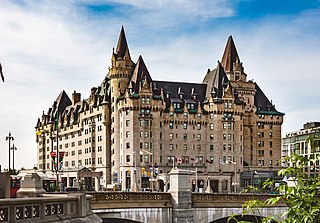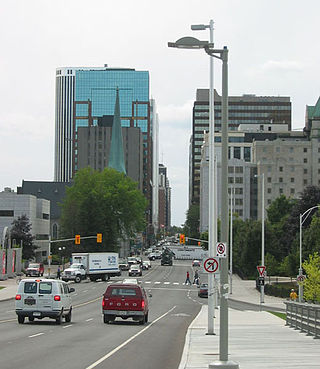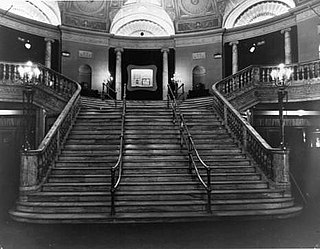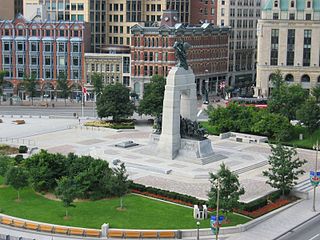
The Fairmont Château Laurier is a 660,000-square-foot (61,000 m2) hotel with 429 guest rooms in the downtown core of Ottawa, Ontario, Canada, located near the intersection of Rideau Street and Sussex Drive and designed in a French Gothic Revival Châteauesque style to complement the adjacent Parliament buildings. The hotel is above the Colonel By Valley, home of the Ottawa Locks of the Rideau Canal, and overlooks the Ottawa River. The main dining room overlooks Major's Hill Park. The reception rooms consist of the Wedgewood-blue Adam Room, the Laurier Room defined with Roman columns, the Empire-style ballroom, and the Drawing Room decorated with cream and gold plaster ornament. The hotel was designated a national historic site in 1980.

Laurier Avenue is a central east west street running through Ottawa, Ontario, Canada. Originally known as "Maria Street" and "Theodore Street", it was renamed in honour of Canadian Prime Minister Sir Wilfrid Laurier. Laurier House, the residence of Prime Ministers Laurier and William Lyon Mackenzie King, is located at the corner of Laurier Avenue East and Chapel Street.

Sparks Street is a pedestrian mall in Ottawa, Ontario, Canada. It was a main street in Ottawa that was converted into an outdoor pedestrian street in 1967, making it the earliest such street or mall in Canada.

The Senate of Canada Building is a government building and former railway station that serves as the temporary seat of the Senate of Canada. Located at 2 Rideau Street in downtown Ottawa, it was known as Ottawa Union Station and served as the city's central railway station from 1912 until 1966. From 1966 to 2018, it was operated by the Government of Canada as the Government Conference Centre. The building currently includes a temporary Senate chamber, as well as some Senate offices and committee rooms.

The Lord Elgin Hotel is a prominent hotel in Ottawa, Ontario, Canada. With 355 guest rooms, it is located at 100 Elgin Street at Laurier Avenue, across from Confederation Park in Downtown Ottawa. The twelve-storey limestone structure was named after James Bruce, 8th Earl of Elgin, the first Governor General of the united Canadas.

The current Ottawa City Hall is the city hall of Ottawa, Ontario, Canada. The downtown complex consists of two connected buildings: a modern wing located on Laurier Avenue and a 19th-century heritage wing located on Elgin Street. Although City Hall has frontage on two major streets, the main entrance is on Laurier Avenue, and the municipal address is 110 Laurier Avenue West.

Downtown Ottawa is the central area of Ottawa, Ontario, Canada. It is sometimes referred to as the Central Business District and contains Ottawa's financial district. It is bordered by the Ottawa River to the north, the Rideau Canal to the east, Gloucester Street to the south and Bronson Avenue to the west. This area and the residential neighbourhood to the south are also known locally as 'Centretown'. The total population of the area is 5,501.

The CBC Ottawa Production Centre is an office and studio complex the serves as the headquarters of the Canadian Broadcasting Corporation. It is located on Queen Street in downtown Ottawa, Ontario, Canada. The building hosts the originating studios for both the CBC's English-language and French-language operations in the National Capital Region. The building was opened in 2004, and contains approximately 37,700 square metres (405,799 sq ft) of office space.

Elgin Street is a street in the Downtown core of Ottawa, Ontario, Canada. Originally named Biddy's Lane, it was later named after Lord Elgin.

Confederation Park(French: Parc de la Confédération) is a public park and National Historic Site of Canada, located in the downtown core of Ottawa, Ontario, Canada. It is bordered on the south by Laurier Avenue and Ottawa City Hall; on the east by the Rideau Canal and National Defence Headquarters; on the north by the Mackenzie King Bridge, the Rideau Centre and the National Arts Centre; and to the west by Elgin Street and the Lord Elgin Hotel.
Dey's Arena, also known as Dey Brothers Rink, Dey's Skating Rink and The Arena, were a series of ice rinks and arenas located in Ottawa, Ontario, that hold importance in the early development of the organized sport of ice hockey in Canada. It was the home arena of the Ottawa Hockey Club, variously known as the Generals, the Silver Seven and the Senators from the 1890s until 1923, although it is known that games were also played at the Rideau Skating Rink in the 1890s and the Aberdeen Pavilion in 1904. The rink and arenas were built by two generations of the Dey family, who were prominent in Ottawa at the time, with a thriving boat works business serving the lumber business. The Dey family also played hockey.

The Ottawa Courthouse is an courthouse in Ottawa, Ontario, Canada. It is the main provincial court for the Ottawa area, and as such handles most of the region's legal affairs. The building is home to the civil, small claims, family, criminal, and district branches of the Ontario Superior Court of Justice. It is also home to the local land registry office. Some 1,000 people use the nine storey building each day.

The Capitol Cinema was the largest movie theatre ever built in Ottawa, Ontario, Canada, and was the city's only true movie palace. Opened in 1920, the 2530-seat cinema was regarded as one of the best cinemas designed by famed theatre-architect Thomas W. Lamb.

The Ford Hotel was a historic hotel in central Toronto, Ontario, Canada. It was one of five hotels in the R.T. Ford & Company hotel chain and was identical to the Ford Hotel, Buffalo and Ford Hotel, Montreal. The 750-room hotel consisted of three 12-story wings connected at the rear by a perpendicular spine atop a one-story base contained the lobby, restaurants and other amenities. The structure was located on Dundas Street West, east of Bay Street. It was built in 1928 and for several decades was one of the city's most prominent hotels. The hotel was next to the Toronto Bus Terminal and provided cheap rooms for lower income travellers. It was also well known as a site for crime and vice. The Toronto Star called it the "rendezvous of choice for couples pursuing an illicit affair."

The Arena, also known as Dey's Arena was an arena for ice hockey located in Ottawa, Ontario, Canada. It was the home of the Ottawa Hockey Club from 1908 to 1923. It was the third in a series of ice hockey venues built by the Dey family of Ottawa. At the time of its building, it was Canada's largest arena.
The Plaza Bridge in Ottawa, Ontario, Canada, is an automotive and pedestrian bridge that crosses the Rideau Canal just south of the Ottawa locks. It joins Wellington Street and Elgin Street in the Downtown core to the west with Rideau Street to the east. The Chateau Laurier abuts the bridge at the east end, while Parliament Hill is just beyond the west end. It is the northernmost bridge over the canal, just north of the Mackenzie King Bridge.

Confederation Square is an urban square in Ottawa, Ontario, Canada, and is considered the second most important ceremonial centre in Canada's capital city, after Parliament Hill. Roughly triangular in area, with Canada's National War Memorial at its centre and the Valiants Memorial at its periphery, the square is bounded by Wellington Street to the north and branches of Elgin Street to the east and west.
This is a timeline of the history of Ottawa.

Central Chambers is a building at the corner of Elgin Street and Queen Street in Ottawa that is a National Historic Site. It is located at 42 to 54 Elgin Street, next to Bell Block. It faces the Canadian War Memorial at Confederation Square. Central Chambers was built between 1890 and 1893 and designed by John James Browne of Montreal, an example of Queen Anne Revival commercial architecture. Formerly serving as an office for the Canadian Atlantic Railway, it now houses the National Capital Commission.






















